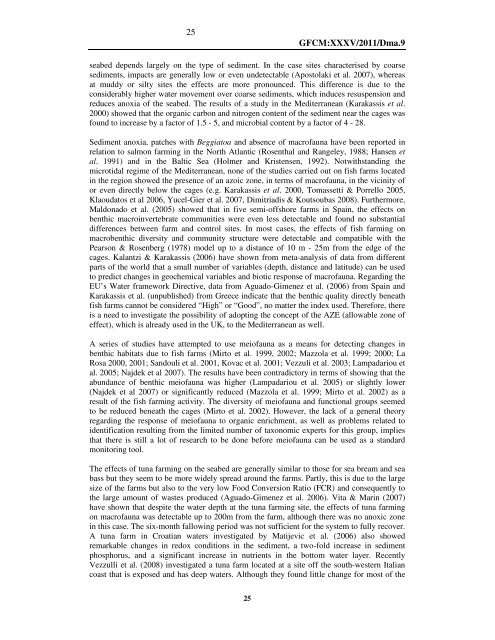Site selection and carrying capacity in Mediterranean ... - FAO Sipam
Site selection and carrying capacity in Mediterranean ... - FAO Sipam
Site selection and carrying capacity in Mediterranean ... - FAO Sipam
Create successful ePaper yourself
Turn your PDF publications into a flip-book with our unique Google optimized e-Paper software.
25<br />
25<br />
GFCM:XXXV/2011/Dma.9<br />
seabed depends largely on the type of sediment. In the case sites characterised by coarse<br />
sediments, impacts are generally low or even undetectable (Apostolaki et al. 2007), whereas<br />
at muddy or silty sites the effects are more pronounced. This difference is due to the<br />
considerably higher water movement over coarse sediments, which <strong>in</strong>duces resuspension <strong>and</strong><br />
reduces anoxia of the seabed. The results of a study <strong>in</strong> the <strong>Mediterranean</strong> (Karakassis et al.<br />
2000) showed that the organic carbon <strong>and</strong> nitrogen content of the sediment near the cages was<br />
found to <strong>in</strong>crease by a factor of 1.5 - 5, <strong>and</strong> microbial content by a factor of 4 - 28.<br />
Sediment anoxia, patches with Beggiatoa <strong>and</strong> absence of macrofauna have been reported <strong>in</strong><br />
relation to salmon farm<strong>in</strong>g <strong>in</strong> the North Atlantic (Rosenthal <strong>and</strong> Rangeley, 1988; Hansen et<br />
al. 1991) <strong>and</strong> <strong>in</strong> the Baltic Sea (Holmer <strong>and</strong> Kristensen, 1992). Notwithst<strong>and</strong><strong>in</strong>g the<br />
microtidal regime of the <strong>Mediterranean</strong>, none of the studies carried out on fish farms located<br />
<strong>in</strong> the region showed the presence of an azoic zone, <strong>in</strong> terms of macrofauna, <strong>in</strong> the vic<strong>in</strong>ity of<br />
or even directly below the cages (e.g. Karakassis et al. 2000, Tomassetti & Porrello 2005,<br />
Klaoudatos et al 2006, Yucel-Gier et al. 2007, Dimitriadis & Koutsoubas 2008). Furthermore,<br />
Maldonado et al. (2005) showed that <strong>in</strong> five semi-offshore farms <strong>in</strong> Spa<strong>in</strong>, the effects on<br />
benthic macro<strong>in</strong>vertebrate communities were even less detectable <strong>and</strong> found no substantial<br />
differences between farm <strong>and</strong> control sites. In most cases, the effects of fish farm<strong>in</strong>g on<br />
macrobenthic diversity <strong>and</strong> community structure were detectable <strong>and</strong> compatible with the<br />
Pearson & Rosenberg (1978) model up to a distance of 10 m - 25m from the edge of the<br />
cages. Kalantzi & Karakassis (2006) have shown from meta-analysis of data from different<br />
parts of the world that a small number of variables (depth, distance <strong>and</strong> latitude) can be used<br />
to predict changes <strong>in</strong> geochemical variables <strong>and</strong> biotic response of macrofauna. Regard<strong>in</strong>g the<br />
EU’s Water framework Directive, data from Aguado-Gimenez et al. (2006) from Spa<strong>in</strong> <strong>and</strong><br />
Karakassis et al. (unpublished) from Greece <strong>in</strong>dicate that the benthic quality directly beneath<br />
fish farms cannot be considered “High” or “Good”, no matter the <strong>in</strong>dex used. Therefore, there<br />
is a need to <strong>in</strong>vestigate the possibility of adopt<strong>in</strong>g the concept of the AZE (allowable zone of<br />
effect), which is already used <strong>in</strong> the UK, to the <strong>Mediterranean</strong> as well.<br />
A series of studies have attempted to use meiofauna as a means for detect<strong>in</strong>g changes <strong>in</strong><br />
benthic habitats due to fish farms (Mirto et al. 1999, 2002; Mazzola et al. 1999; 2000; La<br />
Rosa 2000, 2001; S<strong>and</strong>ouli et al. 2001, Kovac et al. 2001; Vezzuli et al. 2003; Lampadariou et<br />
al. 2005; Najdek et al 2007). The results have been contradictory <strong>in</strong> terms of show<strong>in</strong>g that the<br />
abundance of benthic meiofauna was higher (Lampadariou et al. 2005) or slightly lower<br />
(Najdek et al 2007) or significantly reduced (Mazzola et al. 1999; Mirto et al. 2002) as a<br />
result of the fish farm<strong>in</strong>g activity. The diversity of meiofauna <strong>and</strong> functional groups seemed<br />
to be reduced beneath the cages (Mirto et al. 2002). However, the lack of a general theory<br />
regard<strong>in</strong>g the response of meiofauna to organic enrichment, as well as problems related to<br />
identification result<strong>in</strong>g from the limited number of taxonomic experts for this group, implies<br />
that there is still a lot of research to be done before meiofauna can be used as a st<strong>and</strong>ard<br />
monitor<strong>in</strong>g tool.<br />
The effects of tuna farm<strong>in</strong>g on the seabed are generally similar to those for sea bream <strong>and</strong> sea<br />
bass but they seem to be more widely spread around the farms. Partly, this is due to the large<br />
size of the farms but also to the very low Food Conversion Ratio (FCR) <strong>and</strong> consequently to<br />
the large amount of wastes produced (Aguado-Gimenez et al. 2006). Vita & Mar<strong>in</strong> (2007)<br />
have shown that despite the water depth at the tuna farm<strong>in</strong>g site, the effects of tuna farm<strong>in</strong>g<br />
on macrofauna was detectable up to 200m from the farm, although there was no anoxic zone<br />
<strong>in</strong> this case. The six-month fallow<strong>in</strong>g period was not sufficient for the system to fully recover.<br />
A tuna farm <strong>in</strong> Croatian waters <strong>in</strong>vestigated by Matijevic et al. (2006) also showed<br />
remarkable changes <strong>in</strong> redox conditions <strong>in</strong> the sediment, a two-fold <strong>in</strong>crease <strong>in</strong> sediment<br />
phosphorus, <strong>and</strong> a significant <strong>in</strong>crease <strong>in</strong> nutrients <strong>in</strong> the bottom water layer. Recently<br />
Vezzulli et al. (2008) <strong>in</strong>vestigated a tuna farm located at a site off the south-western Italian<br />
coast that is exposed <strong>and</strong> has deep waters. Although they found little change for most of the
















